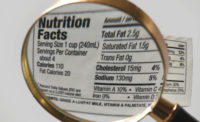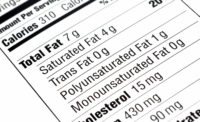How smart labels go beyond the expiration date
The smart label could potentially tell the manufacturer if that item was purchased at the normal retail price or at a promotional price.

It’s no surprise that many of today’s grocery shoppers look at the back of packages for product information and the all-important expiration date. Nobody wants to eat spoiled food, right? Those dates are also handy when you’ve already purchased the items, they’ve been sitting in the fridge and you can’t quite recall when you bought them. Being able to verify “best used by” and expiration dates helps eliminate the possibility of ingesting spoiled food and getting sick.
There are also those instances where the expiration date on the milk, for example, is still two weeks away, but the smell after pouring it into your cereal tells you it’s gone bad. What if there was a better way?
There is with “smart labels.”
Imagine that in addition to the standard product and nutritional label information on food products there is a smart label included on the package. These smart labels provide easy and instantaneous access to information about the lifecycle of the food. Smart labels provide a sensing platform that reacts when food contaminants and other free radicals that indicate spoilage are emitted. This technology will not only change how consumers buy products and what they buy, but may also impact supply chains and consumer products manufacturing in the future.
Similar technology is already being used in the cold food and beverage industry. For instance, temperature-sensitive labels can tell a consumer if a particular food or beverage is at a cold temperature. But, that is just the basics of the technology.
Scientists are investigating how this technology can impact day-to-day life. The technology is in its infancy, but researchers envision incorporating this development into future labels to give clear readouts of when it’s time to toss spoiled food.
Smart labels go beyond food spoilage
There are many other future applications for smart labels. What if you could authenticate refrigerated and frozen food product origins and product characteristics by scanning a label after it has been in the refrigerator or freezer for some time?
Some manufacturers print the packaging dates on products, but many do not. There are codes on packages, but the only people who know what they mean are people associated with the manufacturer. These codes assist in tracking packages in case of a recall. Why can’t the consumer be able to see and understand what the codes mean?
Refrigerated and frozen foods have expiration dates printed on the packages. However, does that expiration date refer to a product that hasn’t been opened yet or one that has? Take ice cream, for instance. The expiration date is three months away, but once the container has been opened, crystals form. Does that mean the ice cream has spoiled? What if a smart label could provide all the key information about when that ice cream was packaged, and more importantly, now that it has been opened, if it’s still safe to eat?
Furthermore, this technology can be used to streamline a product’s distribution and manufacturing and determine future forecasts and raw material needs. Imagine if the smart label on an individual unit could be connected to the license plating information on the carton and pallet allowing handling information to be tracked? The possibilities are endless.
Enabling the entire supply chain
As advanced technologies develop and the food manufacturing industry begins to embrace Industry 4.0, a sensor-embedded smart label could communicate to the consumer, retailer and the manufacturer in a connected world. Today, grocery stores use credit card information to match purchases with store coupons. Technology matches consumer shopping habits with in-store deals based on what people buy. Smart refrigerators are already in production. So, what if the smart label could communicate to the smart fridge, and then communicate with a mobile phone app telling the consumer the frozen peas have freezer burn and need to be replaced?
Taking it one step further, the app doesn’t just tell the consumer it is time to reorder. The data triggers the app to automatically place an order for the peas and other items to the online shopping venue of choice and schedules the delivery based on the consumer’s calendar app. Sounds wild and futuristic right? These situations could be closer to reality than you think.
Going even another step further, all of this data can be linked (potentially through blockchain) right to the manufacturer, providing an immense amount of data at their fingertips. They can see how long an item was in the freezer before freezer burn occurred. The smart label could tell if and when a product was exposed to temperature differentials that could have impacted the integrity of the item.
In addition, the manufacturers’ forecasting and distribution systems can be aided in product forecasting, allowing the company to provide better service and better quality products while at the same time, improving profitability. The smart label could potentially tell the manufacturer if that item was purchased at the normal retail price or at a promotional price. This data could be used to analyze the viability of promotions.
Technology and innovation breed more technology and innovation, and the opportunities for smart labels are potentially endless.
Looking for a reprint of this article?
From high-res PDFs to custom plaques, order your copy today!




